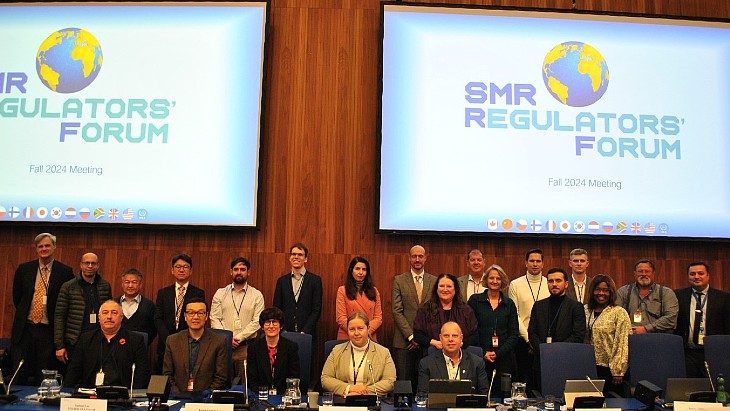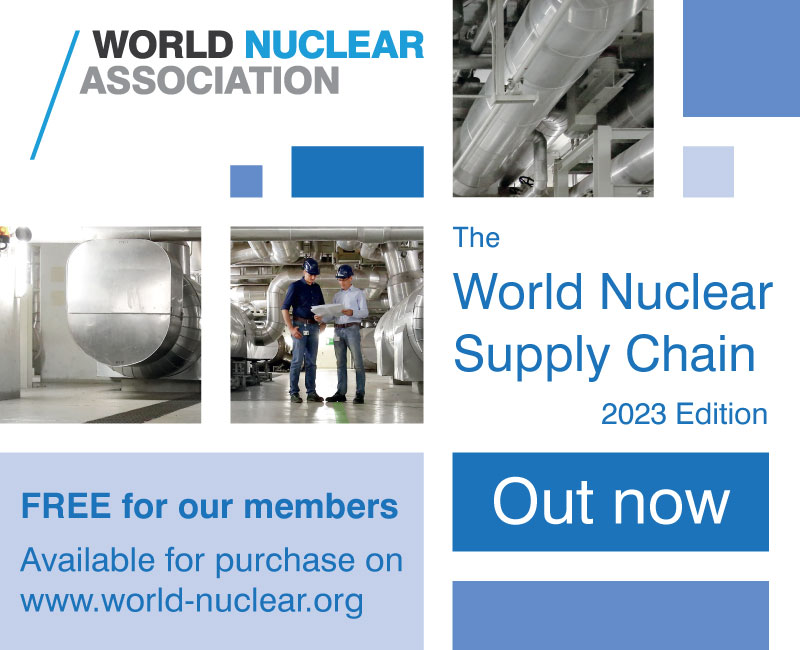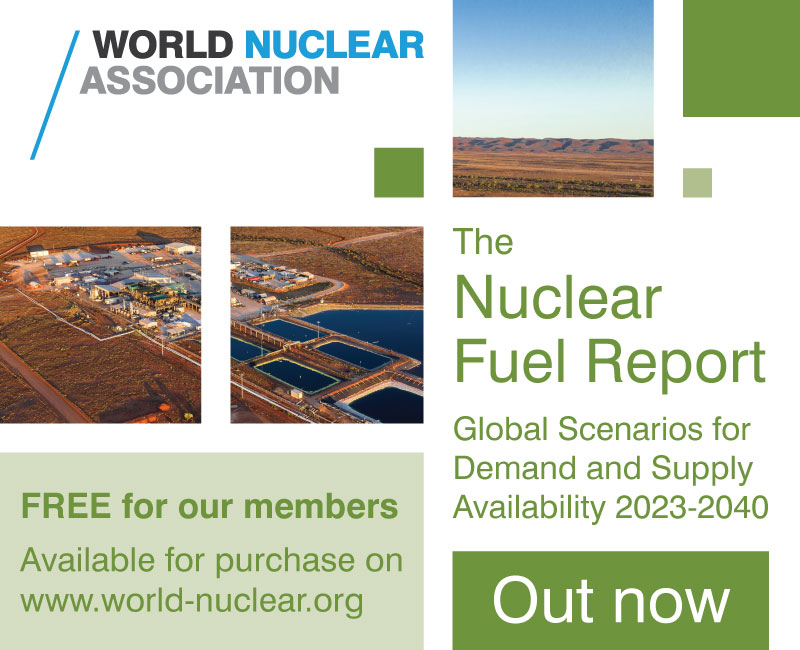Cautious optimism for uranium outlook
 Growth in world uranium inventories is slowing as the supply sector is responding to a gradual recovery in uranium demand, according to speakers at the World Nuclear Fuel Cycle conference held in Madrid on 18-19 April. Uranium resources remain plentiful, but the investment needed to bring resources into production depends heavily on the market, the conference heard.
Growth in world uranium inventories is slowing as the supply sector is responding to a gradual recovery in uranium demand, according to speakers at the World Nuclear Fuel Cycle conference held in Madrid on 18-19 April. Uranium resources remain plentiful, but the investment needed to bring resources into production depends heavily on the market, the conference heard.Growth in world uranium inventories is slowing as the supply sector is responding to a gradual recovery in uranium demand, according to speakers at the World Nuclear Fuel Cycle (WNFC) conference held in Madrid on 18-19 April. Uranium resources remain plentiful, but the investment needed to bring resources into production depends heavily on the market, the conference heard.
 |
| TradeTech's Treva Klingbiel addresses WNFC 2018 (Image: WNFC) |
Adrienne Hanly, uranium resources specialist at the International Atomic Energy Agency, said the world's identified uranium resources are more than adequate to meet even high-case demand scenarios, but potential supply challenges could result in a supply gap over the next five to ten years.
The latest edition of the OECD Nuclear Energy Agency (NEA) and International Atomic Energy Agency (IAEA) joint report on uranium resources, production and demand - known as the Red Book - identified resources to 2015 of 7,641,600 tU at cost categories up to USD260 per kgU. The book's lowest demand scenario - with an installed nuclear capacity of 418 GWe by 2035 and a uranium demand of 66,995 tU per year - could be met by existing and committed uranium production centres supported by reasonably assured and inferred resources recoverable at a cost of up to USD130 per kgU, she said. The Red Book's high demand scenario - with an installed capacity of 682 GWe and a uranium demand of 104,740 tU per year - would see a supply gap.
According to the Red Book, the world's identified reasonably assured and inferred uranium resources, recoverable at cost categories up to USD260/kgU, stood at 7,641,600 tU as of 2015. This is more than adequate to meet high-case demand scenarios, but investment and expertise will be required to bring resources into production, with further potential supply challenges over the next five to ten years from increasing production costs and long lead times.
"There's no shortage of resources - but we have to get them to market," Hanly said.
Inventory and market health
Turning to "above the ground" uranium, Jonathan Hinze, president of UxC, said levels of uranium inventories relative level to uranium demand is a key indicator of the future health of the uranium market.
Inventories are part of every well-functioning market, providing a means of balancing the timing between production and actual demand, he said. Reactor requirements have exceeded global uranium production nearly every year since 1990, with the shortfalls being met by inventory, he said.
Uranium inventories take various forms - ranging from yellowcake through enriched uranium product to fabricated assemblies. Uranium can take from one year and up to four years to process into nuclear fuel, and such long lead times mean that so-called pipeline inventories are important for a well-functioning nuclear supply chain, he said. Other forms of inventory are strategic material held above pipeline requirements for security of supply and other purposes, including compliance with government policies; excess inventory, which is material in excess of pipeline and strategic requirements, but is not necessarily mobile; and non-commercial inventory, which is typically held by governments or fuel banks, such as the international nuclear fuel bank established by the IAEA.
UxC estimates world inventories, as of February 2018, to be around 1.79 billion pounds U3O8e (U3O8 equivalent), Hinze said. Of this, about 53% is held by utilities, 34% by governments and 13% by suppliers, traders and financials. The pipeline requires an inventory of about three years of forward coverage - or 515 million pounds U3O8e - while strategic inventories account for 260 million pounds and trader inventories 35 million pounds. Non-commercial inventories are dominated by the US Department of Energy, which held about 241 million pounds U3O8e as of December 2017, and the Russian government, with an inventory estimated by UxC to be around 368 million pounds U3O8.
Cameco production costs
Cameco's unit cost of production was higher in the first quarter of 2018 due to the suspension in January of production at McArthur River and Key Lake and the change in reporting for its Kazakh operations, JV Inkai, the company said in results published on 27 April. Net earnings of CAD55 million (USD43 million) were higher for the quarter as compared to 2017, largely due to the restructuring of JV Inkai and higher realised prices and deliveries.
An excess of about 365 million pounds U3O8e is held as commercial inventories by utilities, producers, and intermediaries. Much of the commercial inventory held by these is either obligated or held for strategic purposes and only a small portion - perhaps 5-10% - of such inventories can be considered mobile at any given time, Hinze said.
Hinze said that the impact of Fukushima, which prompted the long-term closure of Japan's nuclear power plants, had contributed to the build-up of inventory post-2011, but noted that inventories were already high, and increasing, at the time of the accident in 2011 because of concerns about security of supply.
The increase in inventories is now slowing down as the supply side is responding amid a gradual demand recovery, Hinze said. "The bad news is it's going to take some time to work off [existing inventories]," he said. Government inventory disposition will continue to be dictated by non-market drivers, but nuclear fuel spot markets will be continue to be heavily influenced by the inventory situation, he said.
Speaking in a later session during the conference, Cameco Vice President David Doerksen described how his company had been responding to a "challenging" world uranium market. With 57 reactors currently under construction around the world - and more countries developing nuclear power programmes - the next 12-18 months will be a time of "cautious optimism", he said. Uncovered utility requirements expected to be about 665 million pounds U3O8 (255,790 tU) over the period to 2027.
However, he said, current prices are "nowhere near" those needed to stimulate new sources of supply. Some uranium producers have been protected from market prices by long-term contracts but are now emerging from that protection, he said. This has led producers to take actions including suspending production and shelving development projects. Cameco in 2016 suspended production at its Rabbit Lake operation in Canada and at its US operations, and this year has temporarily suspended production at McArthur Lake, and its production is currently producing uranium at Cigar Lake in Canada, and from its interest in the Inkai joint venture in Kazakshtan.
Doerksen said Cameco expects its share of 2018 production to be 9.1 million pounds U3O8, and purchases of 8-9 million pounds U3O8. With sales deliveries of 32-33 million pounds, "we will have to rely on our inventories, or make opportunistic purchases, to meet these commitments," Doerksen said.
"It seems that many in the industry are relying on inventory … I would suggest that only a relatively small portion of the inventory overhang is truly mobile."
US producers react
US uranium producers EnergyFuels and UrEnergy in January filed a petition with the US Department of Commerce (DOC) seeking an investigation into the effects of uranium imports on US national security and calling for limits to imports to reserve 25% of the US nuclear market for domestic uranium production. Treva Klingbiel, president of TradeTech, provided an overview of the petition, process, timeline and potential impact of the Section 232 petition filing.
The petition centres on uranium from "state-sponsored" producers which it identifies as China, Russia, Kazakhstan and Uzbekistan, which the petitioners believe threaten the viability of the US uranium industry, she said.
Klingbiel said government intervention, such as the "remedy" being sought by the petitioners, was the most extreme way of seeking relief that could be employed by the affected parties in a market under stress. She described the decision to invite government intervention in any industry as a "last resort" signalling that the industry or companies involved are struggling to survive.
"There is no doubt that this is a case for the two US uranium producers who filed the petition," she said, but added that it was also true of the wider uranium industry which is struggling due to low market prices and slower than expected growth.
Implementation of a quota-based remedy would carry risks, many related to the capital costs of bringing new production into operation, she said. US uranium production has been declining for the past five years and is currently at its lowest since 2004. New resources are available but could take some time to come to market, as investment and exploration has been declining over last five years. Klingbiel estimated it could take from three to six years for such resources to be brought into production.
The DOC has up to 270 days to conduct its investigation into the matter, but the ultimate decision on the petition and remedy will rest with the US President, and there is some degree of uncertainty in the timeline that the petition will follow, Klingbiel said. Theoretically the process could take until June 2019 but this will depend on whether the DOC takes the full 270 days, as well as the time taken by the President to issue a decision.
"We should be aware of impending price volatility, which we may expect to see, especially if buyers begin to alter their contracting activity in advance or in anticipation of material changes to the structure of the market," she said.
Researched and written
by World Nuclear News
_49098.jpg)
_57190.jpg)
_75453.jpg)
_70526.jpg)









